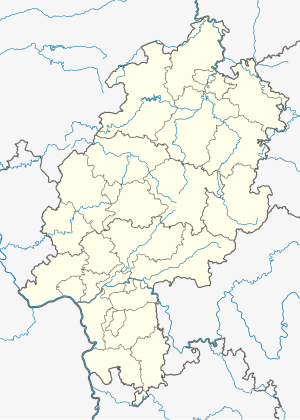Wommen viaduct
Coordinates: 51 ° 1 ′ 0 ″ N , 10 ° 7 ′ 4 ″ E
|
|
||
|---|---|---|
| southern view of the Wommen viaduct (photo 2009) | ||
| use | Highway bridge | |
| Convicted | Federal motorway 4 | |
| Subjugated | Nesse bach and L 3251 | |
| place | Wommen | |
| construction | Vaulted row bridge | |
| overall length | 303.8 m | |
| width | 15.65 m + 16.25 m | |
| Number of openings | 17th | |
| Pillar spacing | 18.05 m | |
| height | 26.50 m | |
| location | ||
|
|
||
The Wommen viaduct is a 303.8 meter long motorway bridge on the A 4 / E 40 north of Wommen ( Herleshausen municipality , Werra-Meißner district , Hesse ) near the state border with Thuringia . The structure spans the Nesse stream and the 3251 road . The federal highway 400 begins immediately to the north .
history
The southern half of the bridge, facing the village of Wommen, was built between 1938 and 1940. Because of the Second World War, only the foundation, six pillars and four vaults could be completed in the northern part. Due to the division of Germany, the structure did not go into operation at first and remained closed until 1990.
Immediately after the fall of the Wall , not only the renovation of the old red sandstone bridge was tackled, but also the planning of a new construction for a second valley bridge running parallel, as the German Unity traffic project to improve the traffic situation on the A 4 federal motorway was of particular importance. The construction of the second bridge for the Kirchheim carriageway took place from 1992 to 1993. For this purpose, the old bridge elements, 7400 m³ of masonry and concrete, were demolished. From 1993 to 1995 the southern half of the bridge was rebuilt and repaired.
description
The viaduct is a 26.5 meter high vaulted bridge with 17 arches, the distance between the pillars between 16.525 and 18.05 meters. Two lanes with hard shoulder are available in each direction of travel.
Compared to the first structure, the northern half of the bridge was shifted 2.3 meters to the north along the axis of the bridge. The dimensions were adopted analogously to the southern half. However, the supporting structure consists of 80 cm thick reinforced concrete arches on which 25 cm thick reinforced concrete transverse panes are arranged at a distance of 3.8 m. The carriageway slab is 25 cm thick and is monolithically connected to the transverse panes. The pillars have a hollow cross-section made of reinforced concrete and are equipped with steel stairs inside. The 14 central pillars are founded on large bored piles with a diameter of 1.3 m and a length of up to 25 m. The elaborate construction method and 5000 m² natural stone facing resulted in construction costs of around 27.3 million DM, which corresponds to 5742 DM per square meter of bridge area and was more than twice as expensive in relation to the area as for similar bridges with conventional prestressed concrete superstructures.
For both bridges, the view in red sandstone was retained. In the new building, however, the undersides of the arches were not veneered for cost reasons. Instead, a colored concrete was used.
literature
- Federal Ministry of Transport: Bridges on federal highways 1995 . Verkehrsblatt Verlag 1995, ISBN 3-89273-072-5 .
Web links
Individual evidence
- ↑ Wolfgang Jäger: A 4 "Thuringian Zipfel" Completion after over 50 years. In: autobahngeschichte.de. April 28, 2016, accessed November 8, 2019 .
- ↑ Federal Ministry of Transport: Bridges on federal highways 1995 . Verkehrsblatt Verlag 1995, ISBN 3-89273-072-5 , pp. 9-10.


